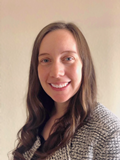|

Sarah E. Lowen
|
|

Nicole Metzger
|
Though note-taking is a required curriculum goal for many instructors, implementation remains a true challenge. Part of the challenge is that students often do not value active note-taking or see the relevance of notes (Andrade, 2006). To encourage students to actively take notes while listening, we have developed a series of activities that use student notes in new and surprising ways. The surprise factor and the variety teach students that their notes should always be taken clearly and in an organized way because they never know what their notes will be used for next. The assumption with these activities is that students are already familiar with various note-taking strategies and techniques. These activities are meant to be quick ways to use student notes in class, and they can all be modified to fit your specific context. However, the first step for all the activities is the same: Students are asked to take notes over a listening sample.
Activity 1: Note Switching (with Circling Answers)
This first activity is simple, but effective. After listening to a sample, students are asked to switch notes with another classmate. Once students complete their notes in class or as homework, you can assess students’ listening comprehension by having them answer listening comprehension questions using someone else’s notes, or by circling the answers in their classmates’ notes. After all the questions are answered, the correct answers can be reviewed in any method you choose.
The idea behind this activity is to help students develop better organizational strategies in their notes (Song, 2012). The aspect of having other classmates or even instructors read through student notes and circle answers shows students the importance of clearly identifying main ideas, supporting details, or even difficult vocabulary in their notes. This activity also serves as a method for students to practice how to organize lecture material in their notes and to actually use their notes for study or as a reference.
Activity 2: Rewritten Notes
The goal here is focused more on the note-taking skills that students need to acquire as part of their ESL coursework. After students write their notes, ask students to read and rewrite them based on guidelines or your feedback. It is strongly suggested that students turn in their rewritten notes for feedback on organization and content. These rewritten notes should be returned to and kept by the students for review or additional activities throughout a semester.
This activity allows students to have detail-oriented practice with note organization. While students are tasked with reorganizing their notes, they should also be noticing areas where there is unfamiliar or incomplete information. This activity forces students to either go back and relisten to the listening sample to fill in the missing information or seek instructor help (especially if the audio is unavailable). A final impact is the constant review of the listening content that occurs subconsciously while students are rewriting. This type of review will aid comprehension that students will be able to retrieve in further assessment (Brown, Roediger, & McDaniel, 2014).
This simple activity opens up a large variety of modification. You can choose how the students rewrite their notes (e.g., Cornell method, outlining, mapping, flashcards) or allow them to choose their preferred method. You can modify the length of time students have to rewrite their notes as well (e.g., immediately after listening, overnight, the next week). The length of time does affect whether emphasis should be placed simply on organizational markers (with immediate rewriting) or with organization, abbreviations, and accurate content (with extended time).
Activity 3: Presentations on Notes
This activity can be useful as a quick lesson while practicing additional listening skills or as a helpful assessment task. After taking notes, ask students to explain either all or portions of their notes to other classmates and to you. When selecting a portion of notes to explain, the most useful excerpts are notes that explain key ideas or difficult vocabulary words, instead of small examples or tangential information. These informal presentations provide time for quick feedback and useful teaching moments.
By asking students to explain their notes, you encourage students to be actively engaged with the content while drawing connections between key concepts. This activity works well in a combined skills class; these informal presentations, through speaking or writing, require students to practice using cohesive devices to make their message clear to their audience.
One modification is the capability to use this activity on listening assessments. One item on the assessment could be a short instructor-written segment of notes over the listening sample. Direct students to explain and expand upon the notes in their own words in a cohesive structure. Alternatively, you could write notes on a whiteboard while listening to selected material. After you have completed your notes, ask students to explain portions. This modification works with all levels of ESL instruction in that it allows students to see examples of guided notes and skills that they can utilize in their own note-taking.
Activity 4: Sensory Deprivation Jigsaw
This final activity addresses a new emerging problem with note-taking: heavy reliance on audio-visuals, such as PowerPoint for note-taking instead of aural production. This in-class activity is designed to demonstrate that though software such as PowerPoint can be a great tool for note-taking, it should not be the only tool used. Before the activity begins, choose an audio sample and a visual aid that corresponds to the audio sample. First divide the class into three groups (equal, if possible). Explain three sets of directions—one set of directions to each of the three groups. The directions should be as follows:
-
The first group gets access to both the audio and visual(s) and will watch, listen, and take notes (in any format).
-
The second group gets access to the audio only and will take notes (in any format). Before the activity begins and before the visual aids are displayed, the students in the second group should turn around or orient themselves so that the visual aids will not be visible to them.
-
The third group gets access to the visual aids only and will take notes (in any format) from the visual aids. This group should listen to music using headphones and their mobile phones so they cannot hear the audio.
After students take notes, rearrange them into three new groups by assigning one member from each original group into each new group. Prepare comprehension questions for each of the new groups. There should be a mix of questions that can only be answered from the visual aid(s) and that can only be answered from the audio. As a group, students should compare and contrast all of their notes to create the best possible answers.
The most important outcome of this activity is for students to understand that visual aids can be useful, but they cannot be the only source of content for their notes. Successful note-taking includes writing down and organizing information from both the audio and visual aids.
Conclusion
Note-taking is important for success in an academic environment, and teaching our students this is vital (Dunkel & Davy, 1989). Using a variety of activities to get students to truly use their notes throughout a class period helps increase motivation and engagement in the classroom while also modeling organized notes. Note-taking is also a very personal endeavor, so providing a wide range of activities to go with the standard practice of taking notes and answering questions reaches a wider range of students. All the activities in this article can be used in any listening classroom to truly hold students accountable for their own note-taking skills.
References
Andrade, M. S. (2006). International students in English-speaking universities: Adjustment factors. Journal of Research in International education, 5(2), 131–154.
Brown, P. C., Roediger, H. L., III, & McDaniel, M. A. (2014). Make it stick: The science of successful learning. Cambridge, MA: Belknap Press.
Dunkel, P., & Davy, S. (1989). The heuristics of lecture notetaking: Perceptions of American & international students regarding the value & practice of notetaking. English for Specific Purposes, 8(1), 33–50.
Song, M. Y. (2012). Note-taking quality and performance on an L2 academic listening test. Language Testing, 29(1), 67–89.
Sarah E. Lowen is a lecturer at the University of Iowa, where she has taught ESL, IEP, and international teaching assistant courses for 5 years. Before this position, Sarah taught EFL through the Fullbright ETA program in South Korea for 3 years. Sarah enjoys bringing creativities to the classroom to make any skill an engaging learning experience for her students.
Nicole Metzger is an instructional services specialist for the Department of World Languages, Literatures, and Cultures at the University of Iowa. Before this position, Nicole taught ESL courses for 2 years at the University of Iowa. Nicole is passionate about helping language instructors use the best tools and technology in their classrooms, especially where speaking and listening come into practice. | 
